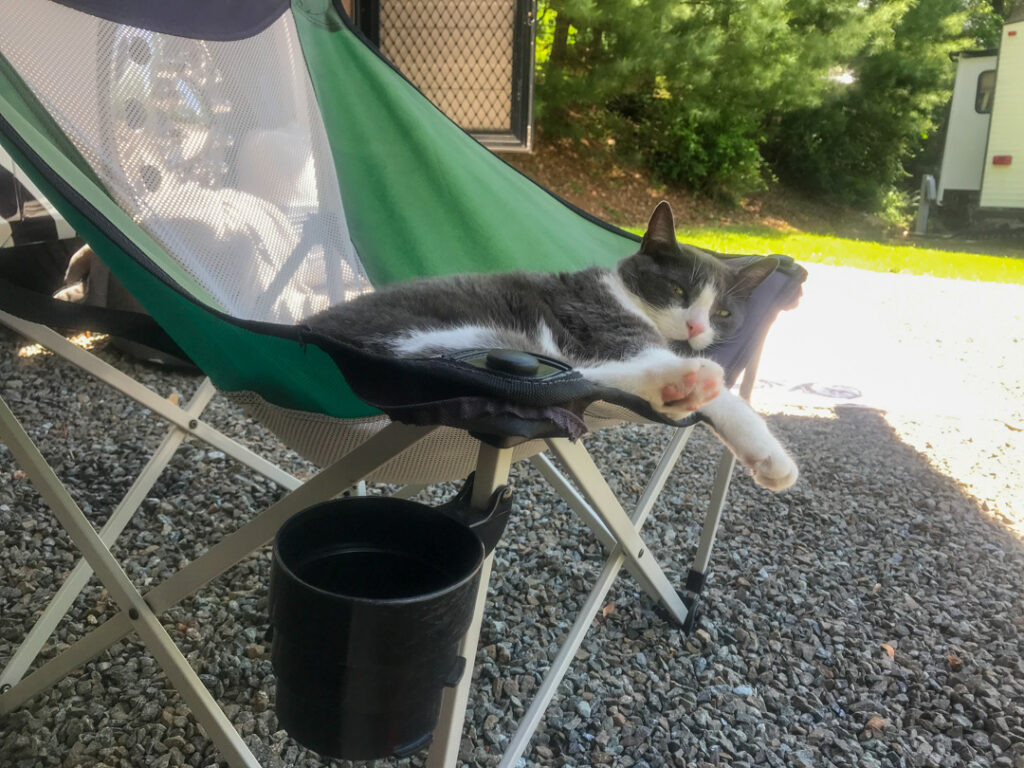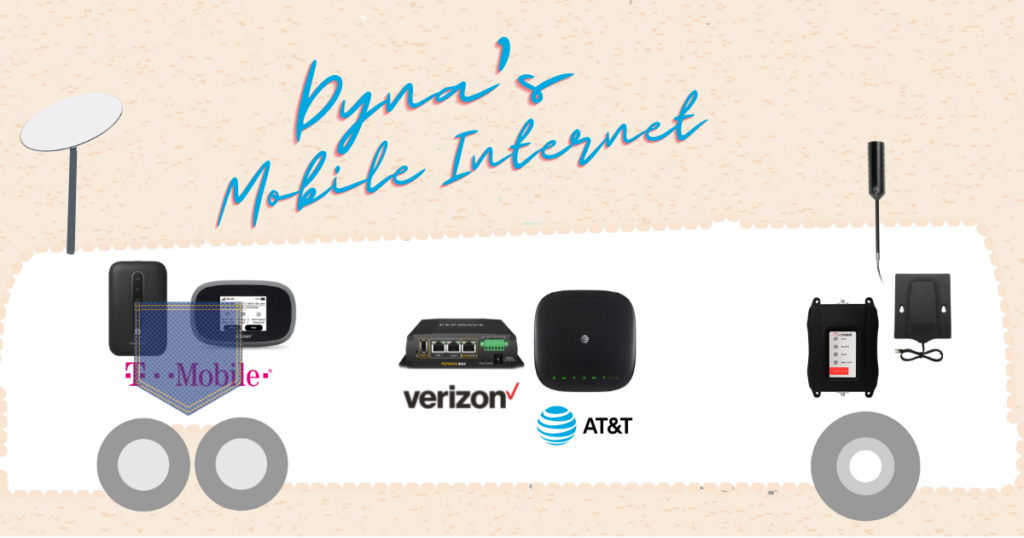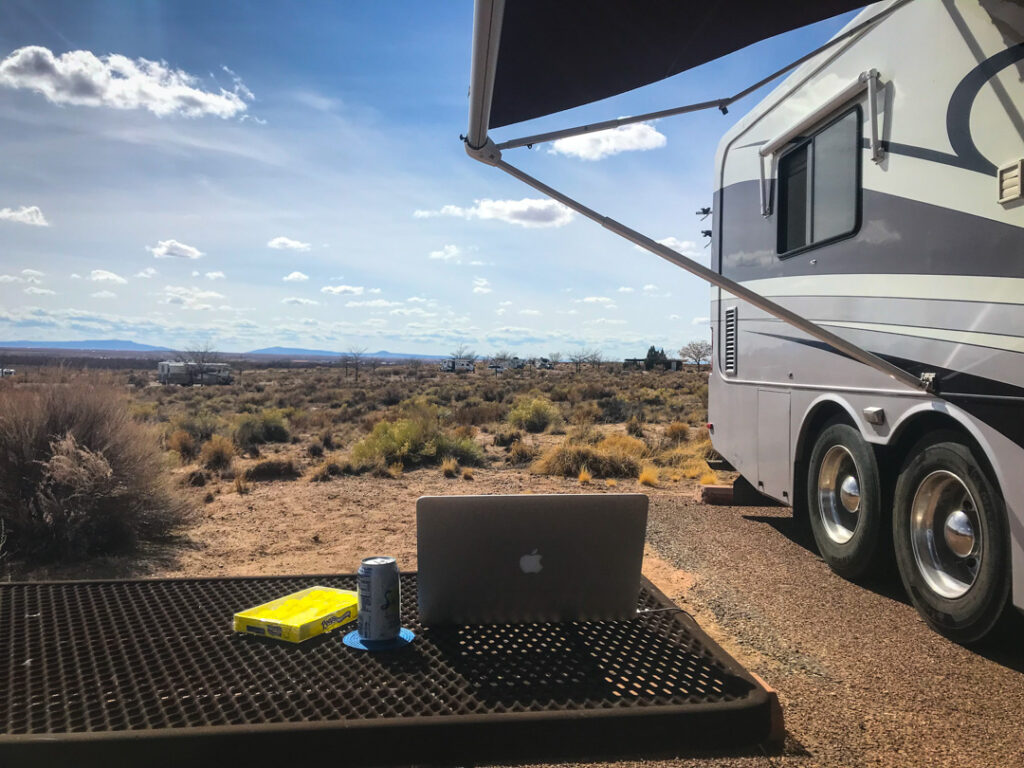(Updated: November 2021)
Ever wonder how we afford to give Lucy the cat a nice life?
Or pay for the endless fuel and sporadic repairs Dyna seems to need?
Or buy all that beer and all that candy in all those different places we park?
Answer: Lucy works a full-time job.
Ok, that’s a lie. But she does spend a lot of time laying on our laptops.
We both work. Remotely.
And to work remotely, we both need to have access to the internet. But we live in an RV. Which means we can’t get internet via a magical cord – like that which runs into a typical house.
Jake is a web developer who telecommutes full-time for an (awesome) company out of the DC area.
Liz writes and maintains content, researches, and moderates for The Mobile Internet Resource Center, a company run by fellow RVers who focus on all things mobile internet. She also provides customer support for Campendium.
The whole working for a mobile internet research company is very convenient; it means we stay pretty up to date on the latest and greatest tech and plans for maintaining workable internet while traveling.
So, how do we keep online?
Behold:
We utilize the awkwardly shaped cabinet above our front windshield to hold the numerous, magical small devices that play a role in keeping us connected.
This conglomerate of electronics typically does a pretty decent job of keeping us online to be able to voice and video conference, check-in code, be available on Skype, blog, and monitor social media (hey, that’s really part of Liz’s job!) Usually, it even allows us to play Roblox with our nephew – which may be more important than keeping online to be able to work.
And when the magical devices are unable to keep us connected, we use our wheels to roll our home to somewhere where we can find a suitable connectivity. Or head to Starbucks or the public library for the day.
Unless it’s the weekend. Then we typically say “screw it” and don’t worry about the no-internet access issue until Sunday night.
Cellular Data Plans
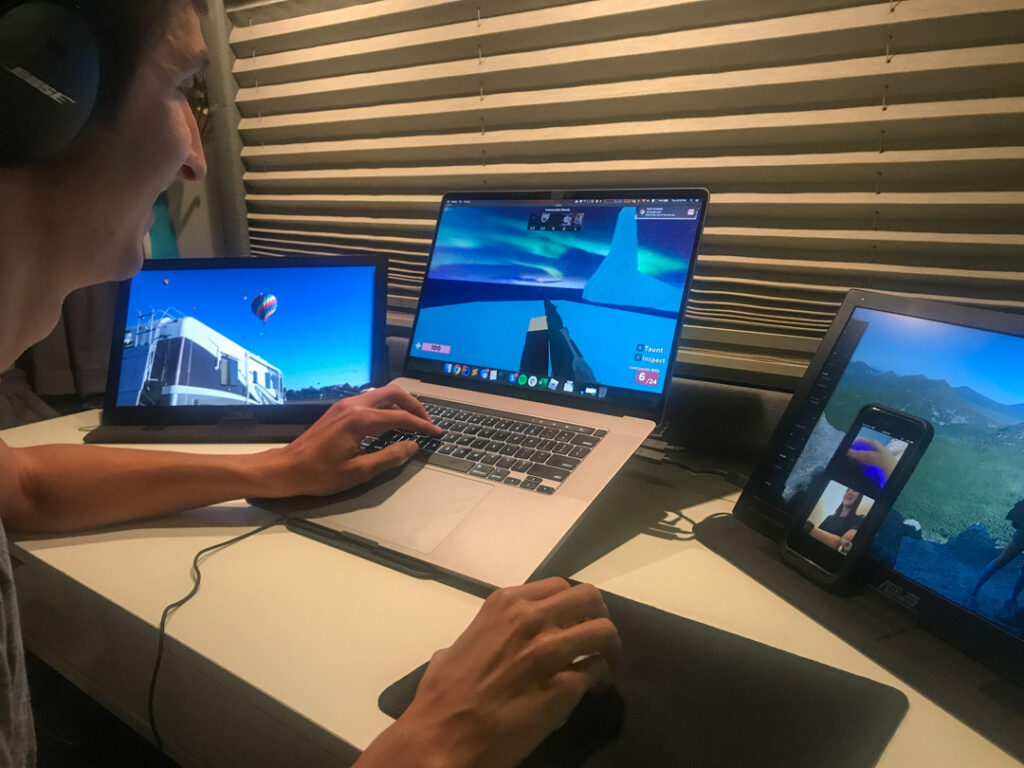
The core of our internet set-up consists of cellular data plans. Yep, we almost always use cellular data to get online.
If you have a phone plan, you may be aware that cellular data is really freaking expensive. Especially if you are using it as your main source of internet.
But, there are options. And we are currently pretty happy with the options we’re using.
- Grandfathered Verizon Unlimited Data Plan (gUDP)
- We assumed liability of a Verizon gUDP back in December 2015. Verizon gUDPs are pretty awesome in that they offer truly unlimited data for what is currently considered an absurdly low price on what is currently the largest cellular network in the U.S. When you travel all over the place in the US, it’s a good idea to have the biggest network in terms of coverage on your mobile internet team.
- Verizon gUDPs don’t have data caps for hotspotted data and are not subject to network management.
- We paid $700 for the gUDP upfront (to own the line), and now pay $73/month (with taxes) per month
- The plan is no longer available to new customers
- AT&T Rural Plan 250GB
- We jumped on a limited-time offer that AT&T put out in March 2017 for specific zip codes (yay for being South Dakota residents!)
- This addition added some redundancy to our set-up, for those times when Verizon coverage might suck, or towers are overloaded
- 250GB of data on the nation’s second-largest carrier in terms of coverage
- $70/month
- This plan is no longer available to new customers
Low Earth Orbit (LEO) Satellite Internet
We snagged a Starlink system back in June 2021 while it was still in beta. The system itself cost $499 up front, and now costs us $99/month for unlimited, hypothetically blazingly fast, data.
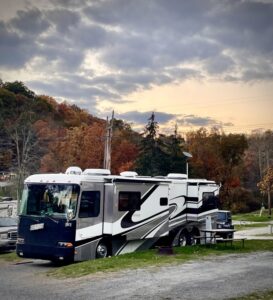
We have been utilizing a Generation One Starlink system (the round dish) to fill out gaps in cellular coverage – or more realistically, whenever we can jump on an open cell and park in an area with enough open sky to support a functional experience. Starlink data is amazingly fast, and blissfully unlimited – when we can get it.
We have experienced some dropout issues when the satellite we are connected to passing behind an obstruction. Our router’s bonding capabilities (see ‘routers’ below) has helped with this if we’re using the system in a location that also has usable AT&T or Verizon data.
We have been testing a Starlink FlagpoleBuddy mount attached to our rig’s ladder. When we’re in a location where this positioning provides a good view of the sky, we really like this mount. However, there have been times where the unit is better positioned towards the front of the rig’s roof – or on the lawn out front of the rig.
Routers & Standalone Hotspot Devices
We run our AT&T data plan through the very basic router that plan is tied to, and run our Verizon gUDP through a more capable router.
- Our Verizon gUDP runs through a Pepwave MAX Transit LTEA, a highly capable router device with dual SIM slots, although we are currently only utilizing one because our main backup date plan is an:
- AT&T 250GB Plan runs off of the AT&T Wireless Internet Router (NetComm IFWA-40), a funky sort-of-mobile-hotspot that the plan is tied to. Therefore, we can’t utilize this plan in the more capable MAX Transit, but we haven’t had too many issues with that. This version of the device (we previously had a HomeBase Device – the prior version of eligible device) does have two SMA antenna ports, which we have put to use when needed.
We have appreciated the MAX BRI for a few reasons beyond super powering our Verizon gUDP plan:
- It offers bonding capabilities (at additional cost), which has saved our butts a few times while in the Northeast in 2021, where both Starlink and cellular coverage tend to be impeded by natural obstacles like mountains and trees. By bonding our connections together, we experience a more consistent data use experience.
- It gives us better Wi-Fi range so that I can surf the web or watch a girl show on Netflix with Lucy in the bedroom while Jake works up at his desk in the front of the RV. Or so that I can work outside at a picnic table or from my hammock and still have access to our data while Jake does too.
- Lets us connect our devices (computers, TV, phones) to one network, rather than having to figure out whether Verizon or AT&T or the park Wi-Fi (haha – usually not) is strongest for that area. The router decides for us.
Signal Enhancing
We then have the option to boost our cellular signals via a weBoost 4GM booster, which we pair with a 4G OTR trucker antenna that Jake attached to our batwing antenna (for picking up local TV channels over the air). Honestly, we rarely use this piece of equipment.
More often, we utilize a Netgear MIMO Antenna to enhance a signal when needed. We always test against the speeds of our booster’s effects versus the MIMO’s enhancement when we need to signal enhance.
Back-Up Plans/Devices
While we do clear out our tech cabinet at least once a year. Tech tends to sneakily compile and you don’t even realize it until one day you realize that maybe tripping over that circa 1998 iMac 3G really isn’t necessary. But, we do keep a few backup devices (and even a plan!) for those ‘good heavens why is nothing working right now‘ moments.
- An 8800L mobile hotspot device. Prior to our Transit, this is the device that powered our gUDP. We keep it handy in the case that something bad happens with the Transit. Like a lightning strike. Or a dinosaur attack.
- A T-Mobile TestDrive hotspot and plan. Hey, both were free. And you never know!
Miscellaneous Pieces
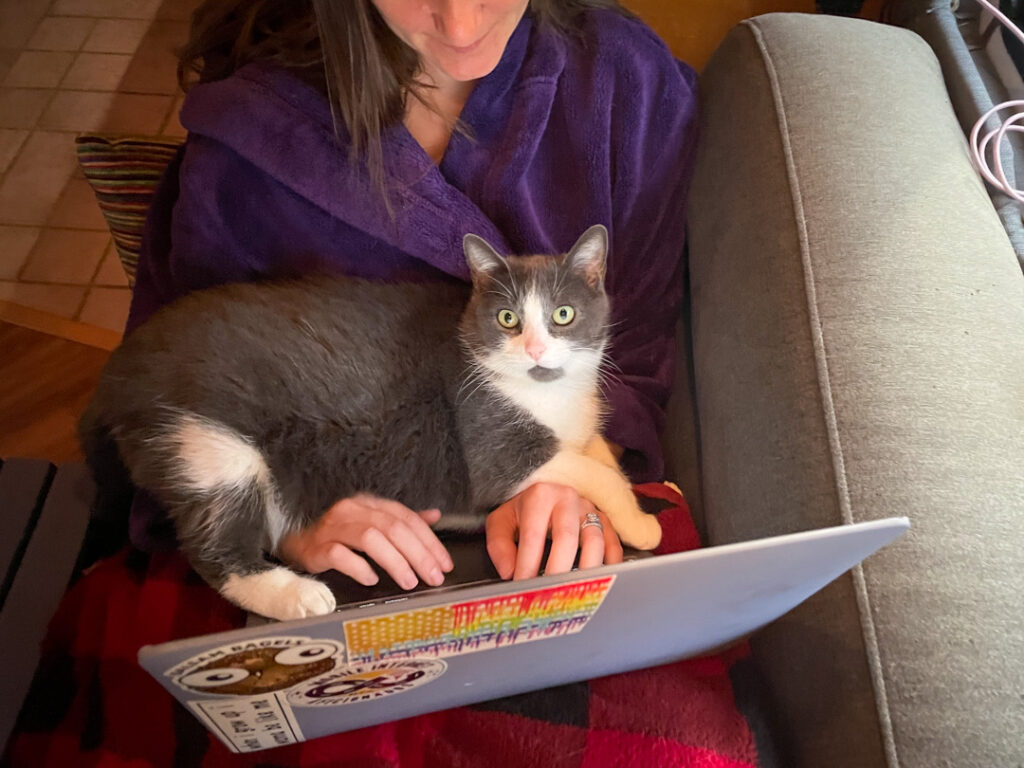 We also carry a completely separate family phone plan on Verizon – just like any regular phone user might. We made the jump from a capped data plan with 16GB per month (which supported 4 family member phone lines) to Verizon’s 2020 edition of Unlimited plans. We currently have both of our personal phones on the Do More Unlimited plans, which offers us each 25GB of mobile hotspot data. We use our phone mobile hotspots semi-frequently; satelitte vehicle trips when one of us has to check-in for work, or working poolside when our nephew visits.
We also carry a completely separate family phone plan on Verizon – just like any regular phone user might. We made the jump from a capped data plan with 16GB per month (which supported 4 family member phone lines) to Verizon’s 2020 edition of Unlimited plans. We currently have both of our personal phones on the Do More Unlimited plans, which offers us each 25GB of mobile hotspot data. We use our phone mobile hotspots semi-frequently; satelitte vehicle trips when one of us has to check-in for work, or working poolside when our nephew visits.
For those ‘in the know’ re: mobile internet tech, ours isn’t exactly cutting edge or the ‘latest and greatest’. But, we have found it works for us. And we find that we can upgrade pieces and parts of the set-up as needed, which we have done consistently.
When we first hit the road we were paying $~320 per month just for data (internet) on a capped Verizon hotspot data plan with 30GB. And because the plan was capped, we had to watch our data usage constantly. Which meant no Netflix. Or cat-slap youtube videos. Or Roblox with the nephew.
 On top of that ~$320 data cost, we also had a grandfathered AT&T on device-only unlimited data plan that we were paying $80/month for. This plan wasn’t useful for much other than surfing the web on the phone, making phone calls, and streaming a show via HDMI mirroring the phone to a TV. This also meant that Jake couldn’t use his phone while I was using it to watch my shows with Lucy. And that was lame. But we held onto it until we found something better – which turned out to be the Mobile Internet Resource Center.
On top of that ~$320 data cost, we also had a grandfathered AT&T on device-only unlimited data plan that we were paying $80/month for. This plan wasn’t useful for much other than surfing the web on the phone, making phone calls, and streaming a show via HDMI mirroring the phone to a TV. This also meant that Jake couldn’t use his phone while I was using it to watch my shows with Lucy. And that was lame. But we held onto it until we found something better – which turned out to be the Mobile Internet Resource Center.
Chris & Cherie of the Mobile Internet Resource Center shared their expertise in all things mobile internet and ended up saving us over $150/month. And this new cheaper set-up we had created by using their knowledge was also more functional, stress-free, and usable than our initial $400 set-up.
Now we don’t have to watch data caps, don’t have to share devices, and don’t have to worry about Verizon having overloaded towers (as much).
And then a little later on down the road, Chris and Cherie also gave me a job (which I love). Cool, right?
So, there it is. How we travel full time and still work online. When the cat lets us.

